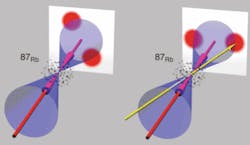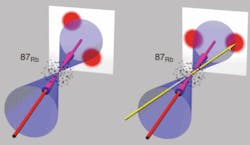All-optical switch controls strong beams with weak ones
Current schemes for all-optical switching generally require a relatively strong beam of light to induce switching in a relatively weak signal beam, according to researchers at Duke University (Durham, NC), who report they have reversed the existing paradigm with a method that may eventually provide single-photon control for telecommunications as well as quantum computing.
Strong beams are usually used to control weak ones to overcome the relatively weak nonlinear optical interaction strength in most materials, according to a paper recently published by research team leader Daniel Gauthier and colleagues at Duke. The Duke team, which also includes graduate student Andrew Dawes, post-doctoral research associate Lucas Illing, and former undergraduate student Susan Clark who is now at Stanford University (Palo Alto, CA), appears to have overcome this difficulty by shining two identical counterpropagating laser beams into warm rubidium vapor, which allowed the researchers to take advantage of both quantum-interference effects and “the extreme sensitivity of instability-generated transverse optical patterns to tiny perturbations.”1
Because the wavelength of the counterpropagating pump beams was close to the 780-nm transition resonance of rubidium vapor, instabilities were generated at relatively low optical power levels (mirrorless parametric self-oscillation) due to strong nonlinear coupling between the pump beams and the rubidium atoms. Under these conditions, very small fluctuations in the electromagnetic field strength caused new beams of light to be emitted forward and backward from the intersection of the pump beams, along cones centered on the axes of the pump beams (see figure). A relatively weak switching beam-four to five orders of magnitude weaker than the pump beams-was then used to control the direction of the emitted light.
“What’s important here is that this is an all-optical switch, using only light, with a weak beam affecting a strong one, which makes the switch cascadable,” said Gauthier, who led the research team. “That’s what you need to be able to have the output of one switch affect the input of another switch downstream. No other group we know of has demonstrated this in an all-optical switch.”
Attempting to extend the technique to telecommunication applications, for instance, would require replacing the rubidium vapor with a gas that would provide transitional resonance at telecommunication wavelengths, such as acetylene or hydrogen cyanide. Another suggested potential application, for the general methodology of exploiting the sensitivity of patterns to small perturbations, might be to enable single-atom switching for manipulation of ultracold quantum gases.
So far the researchers have successfully operated their all-optical switch with a control beam containing only 2700 photons, and they believe that reduction in the power of the pump beams and optimization of vapor cell geometry might allow the single-photon switching that could enable a number of quantum-computing operations. The researchers also suggest that the unprecedented weakness of their control beam indicates that achievable optical switching speeds may ultimately be a good bit faster than previously calculated limits based on thermal-energy dissipation.
REFERENCE
1. A. M. C. Dawes et al., Science308, 672 (April 29, 2005)

